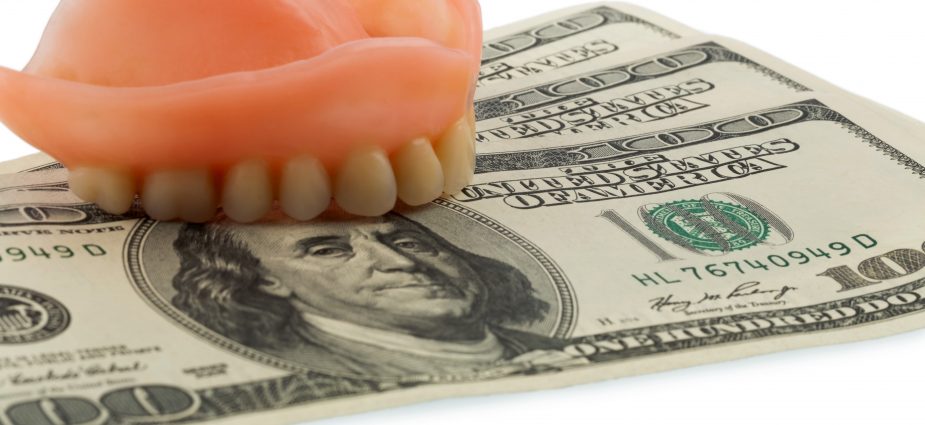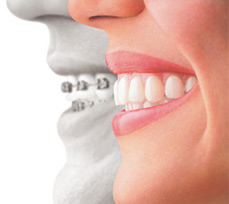Invisalign – How it Works & What it Costs?
Medically Reviewed by: Thomas E. Dudney, DMD

Invisalign is a removable orthodontic appliance offered as an alternative to more traditional orthodontic solutions. A type of clear tooth aligner, Invisalign is intended for people who find the idea of a mouthful of metal braces and brackets – however effective – too unattractive to commit to. If you’re a candidate, you can maintain your smile aesthetics while straightening your teeth.

The Invisalign System
The use of a series of removable aligners for the adjustment of occlusion (bite) is not new. The Invisalign method is based on a concept first introduced in the 1940s and revisited in the 1970s that required a series of dental impressions to determine the optimal position of the teeth. The update method is simpler than its predecessors, requiring only one set of impressions and photographs of the teeth, taken during an initial consultation.
These impressions are used to create a three-dimensional computer projection of how the teeth could be moved incrementally, forming the basis for developing a series of custom-made aligners designed to accomplish this movement.
Invisalign aligners are manufactured at the Align Technologies dental laboratory using computer-aided design/computer-aided manufacturing (CAD/CAM) processes. The aligners are sent to the dentist, who typically dispenses them in groups of one or two at a time during regular check-up appointments (about every four to six weeks) so that treatment can be properly managed. Each aligner must be worn in its specific order for about two weeks, during which time it moves the teeth in small increments of about .25 millimeters to .33 millimeters. Although the aligners are removable (for eating, drinking certain beverages and brushing/flossing), they must be worn at least 20 hours a day in order to reposition the teeth successfully.
A typical treatment requires 20 to 30 aligners for both the upper and lower teeth. Most adults complete their treatment in less than one year. However, treatment time depends on the specific alignment problem.
Are You a Candidate?
Invisalign is currently approved for adults and teenagers with completely erupted permanent teeth who can faithfully follow the directions for treatment – how long they have to wear the aligners each day, what they can and cannot eat and drink, seeing their dentist for follow-up appointments, etc. For example, dentists recommend that you drink only water while wearing aligners, to prevent staining of the plastic. If you do not follow treatment recommendations, you may compromise treatment success.
According to researchers and Align Technologies, Invisalign can be used to correct the following types of mild dental problems:
- Overly crowded teeth. When there is not enough room in the jaw for all of the teeth to fit comfortably or normally (one to five millimeters).
- Widely spaced teeth. When there is too much space between the teeth due to abnormal growth of the jaw or shifting of the teeth due to missing teeth (one millimeter to five millimeters).
- Overbite/overjet. When the upper teeth bite over the lower teeth.
- Crossbite. When the upper and lower jaws are misaligned, causing one or more upper teeth to bite on the inside of the lower teeth, on either the front and/or sides of the mouth.
- Mild relapse. After traditional braces have been removed, when some relapsing tooth movement has occurred.
- Invisalign may also be a treatment alternative for certain simple malocclusions (bite irregularities).
How Much Does it Cost?
The cost of Invisalign treatment is comparable to that of traditional braces – ranging from $3,000 to $9,000 (based on the U.S. national average). However, only your dentist can determine the actual cost of treatment because it will be based on your specific needs, including how extensive your dental problems are, how long your treatment will last, etc.
Payment options or financing may be available through your dentist’s office. If your dentist doesn’t offer financing, you may be able to enlist the services of a third-party financing company like CareCredit or Capital One.
Additionally, orthodontic coverage through a dental insurance plan may cover Invisalign in the same manner that traditional orthodontic treatments are covered. Consult your dental insurance policy to determine which orthodontic benefits you may qualify for.
Compared with Traditional Orthodontics
Invisalign may not be appropriate for certain cases of misalignment or complex bite problems. Fixed orthodontic appliances (traditional wire and bracket braces) can be used for complex malocclusions.

Images courtesy of Align Technology, Inc.
Though not as esthetically appealing as clear aligners, today’s traditional braces have been improved so they are smaller, less visible and more efficient. These newer wire-and-bracket braces also help to correct misalignment much faster than before.
Only a dentist can determine which treatment option might be right for you. In addition, an orthodontic specialist (orthodontist) can advise you about orthodontic treatment alternatives. If Invisalign is not appropriate, traditional orthodontics can still be used for such conditions as:
- Crowding and spacing greater than five millimeters.
- Skeletal malocclusions.
- Discrepancies involving centric-relation/centric-occlusion (how the upper and lower jaw joints and jaw muscles close together).
- Teeth that are severely rotated.
- Open bites in the front and back of the mouth that need to be closed.
- Teeth that are severely tipped.
- Upper or lower jaws with multiple missing teeth.
Invisalign Certification
Not all dentists or orthodontic specialists use Invisalign. Align Technologies specially trains dentists to use the aligners. As of April 2007, an estimated 20,000 general dentists in the United States had trained in how to prescribe Invisalign and become certified by Align Technologies to prescribe the aligners to their patients.
However, it is important to understand that a certified Invisalign dentist may not necessarily be an orthodontist. Being an orthodontist is not a prerequisite for certification.
Learn more about how an orthodontist differs from other dentists.
About the Reviewer

Thomas E. Dudney, DMD, is a highly experienced dentist offering an array of dental services through his Alabama-based practice, Alabaster Aesthetic Dentistry. A graduate of the University of Alabama in Birmingham School of Dentistry, Dr. Dudney has previously served as the Clinical Director for the Aesthetic Advantage hands-on programs taught by Dr. Larry Rosenthal at New York University and the Eastman Dental Clinic in London. He has also served as Clinical Director for the California Center for Advanced Dental Studies (CCADS) live patient hands-on programs and is currently the Clinical Director for Pacific Aesthetic Continuum (PAC) hands-on programs.
Dr. Dudney is a member of the American Dental Association, the Alabama Dental Association and the American Academy of Cosmetic Dentistry, and an accredited member of the American Society for Dental Aesthetics and a Diplomate of the American Board of Aesthetic Dentistry.


